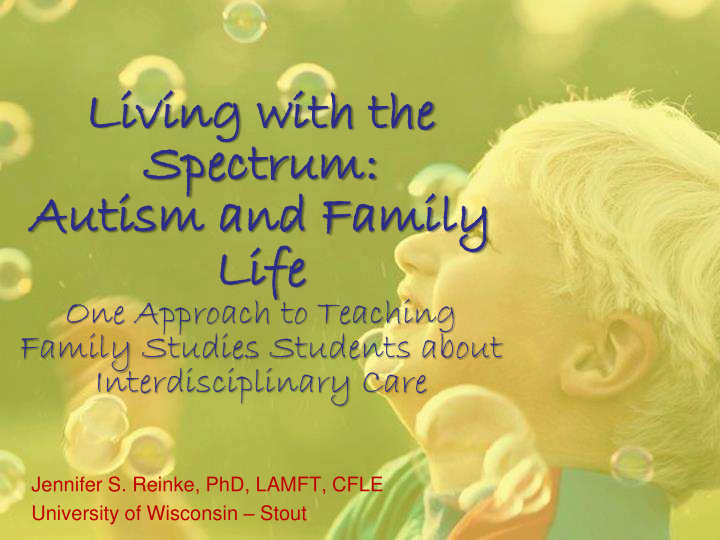



Li Living ing wi with the e Sp Spectrum ectrum: : Aut utis ism m and nd Fa Fami mily ly fe Li Life One Approach to Teaching Family Studies Students about Interdisciplinary Care Jennifer S. Reinke, PhD, LAMFT, CFLE University of Wisconsin – Stout
“a cluster of lifelong neurodevelopmental disorders marked by significant qualitative limitations in social interactions, verbal and nonverbal communication, and restricted repetitive and stereotyped patterns of behavior, interests, and activities” (American Psychiatric Association [APA], 2000)
Back Ba ckgro round nd • Spectrum disorder (mild - severe) • 1 in every 68 births in United States • “Discovery” attributed to Dr. Leo Kanner, 1943 • Despite many theories, cause(s) of autism are not known • There is no “cure” for autism (American Psychiatric Association [APA], 2000; CDC's Autism and Developmental Disabilities Monitoring (ADDM) Network, 2014)
If f yo you have met on t one pe perso son n wit ith autis tism, , yo you have met ON t ONE person on wit ith autis tism.
Ch Chara ract cter eris istics of Au ics of Autis ism Common co-occurring diagnoses: Autism core symptoms: • Intellectual disability • Social interaction • Speech/language delays • Qualitative impairment in • Adaptive skill deficits communication • Repetitive behaviors and • Attention challenges restricted interests • Hyperactivity/impulsivity (ADHD) • Aggressive behaviors • Anxiety/depression • Seizures • Sleep problems (Barbaresi, Katusic, & Voigt, 2006)
Social Worker Alternative Nutritionist Therapy Professionals Extended Behavioral Family Therapist Music Siblings Therapist Speech Parents Therapist Care Team Sleep Medical Professional Specialist Physical Psychologist Therapist Special Occupational Education Therapist Teacher Skills Feeding Trainer Specialist Family Professional
So Wh What? • Highly probable students will engage with individuals and families affected by autism • Family professionals must be knowledgeable about the many care team members involved in supporting families affected by autism – What is their role? – What is my role? – What is the family’s role?
HD HDFS FS 370 370/570: 570: Li Livi ving ng wit with th the Spectr ctrum m Au Autis ism and nd Fa Famil ily Li Life fe • Theoretical frameworks • False beliefs about autism • Impact on family relationships • Cultural considerations • Ethical considerations • Policy issues • Implications for family practitioners
Small ll Gro Groups: Ca Case Studi dies 1) As a group, identify the primary care team members in the scenario 2) Each group member is to assume the role of one of the care team members • Take 2 minutes to brainstorm “your” priorities and desired outcomes Hold a care team meeting! 3) • M ake sure that each team member’s voice is heard • Work together to identify a solution that everyone can agree on
Small ll Gro Groups: Debri rief ef • What might be rewarding about being a member of an interdisciplinary team? • What might be challenging? • What are your reactions to this activity? – Did it help you further clarify your role as a family professional? – Did it further muddy your role as a family professional? – How might this activity be similar to or different from a “real” care team meeting?
Does s it it Wo Work rk? • Expressed deepened appreciation for rewards and challenges in addressing stakeholders’ interests • Demonstrated critical thinking about role as a family professional • Expressed confidence in applying an interdisciplinary approach across settings
Re Refe ferenc rences es American Psychiatric Association. (2000). Pervasive developmental disorders. In Diagnostic and Statistical Manual of Mental Disorders (Fourth edition-text revision (DSM-IV-TR). Washington, DC: American Psychiatric Association, 69-70. Autism and Developmental Disabilities Monitoring Network. (2014). Prevalence of autism spectrum disorders among children aged 8 years - Autism and developmental disabilities monitoring network, 14 sites, United States, 2010. Morbidity and Mortality Weekly Report Surveillance Summaries, 63 (SS02), 1-21. http://www.cdc.gov/mmwr/ Gabovitch, E. M., & Curtin, C. (2009). Family-centered care for children with autism spectrum disorders: A review. Marriage & Family Review, 45 (5), 469-498. doi:10.1080/01494920903050755
Co Cont ntact ct Inf Inform rmatio ion Jennifer S. Reinke, PhD, LAMFT, CFLE Assistant Professor University of Wisconsin – Stout Human Development and Family Studies Phone: 715-232-1405 Email; reinkej@uwstout.edu
Recommend
More recommend